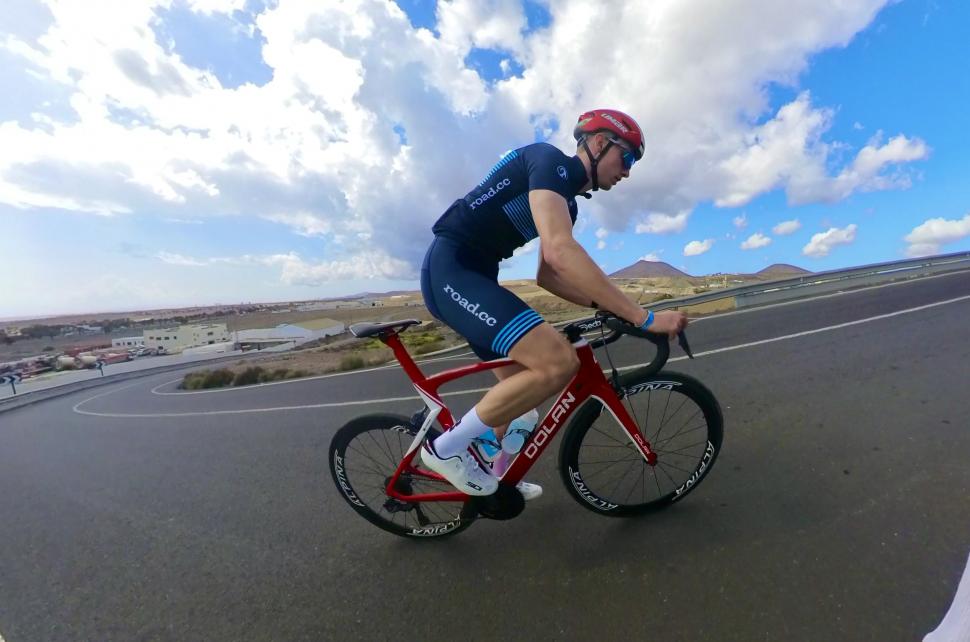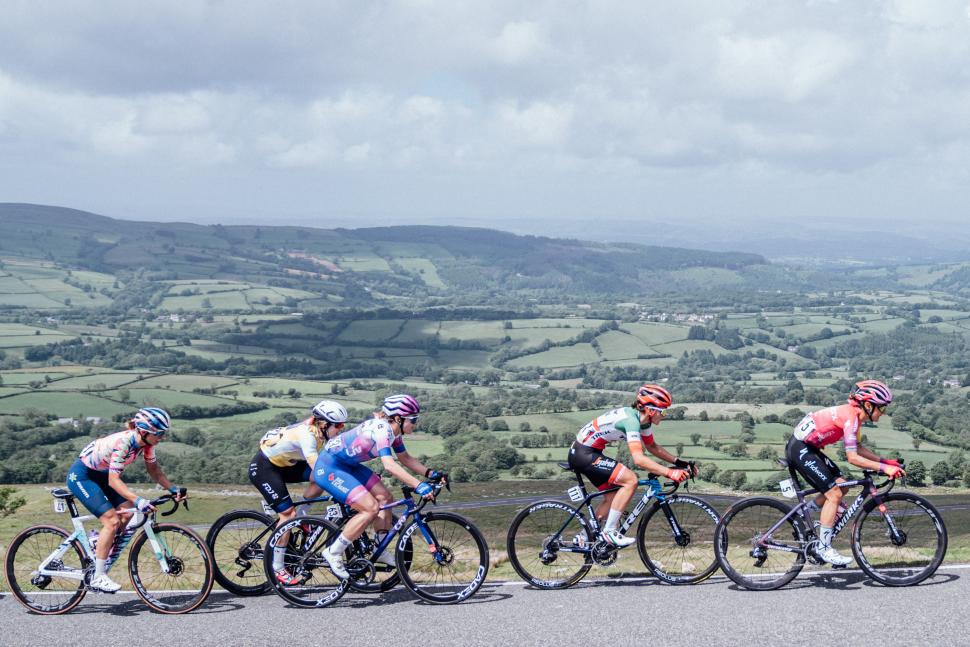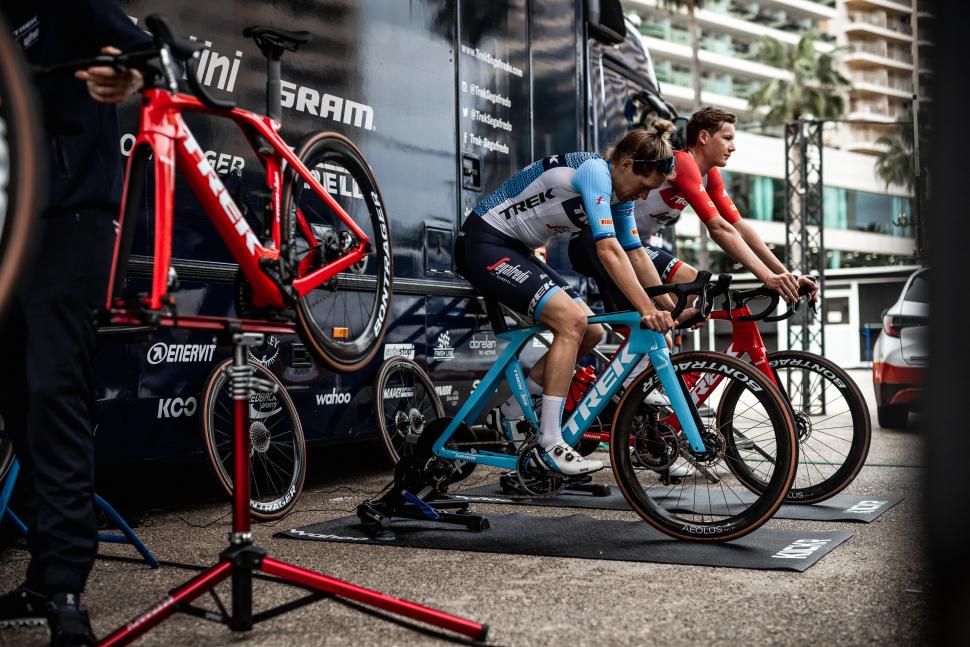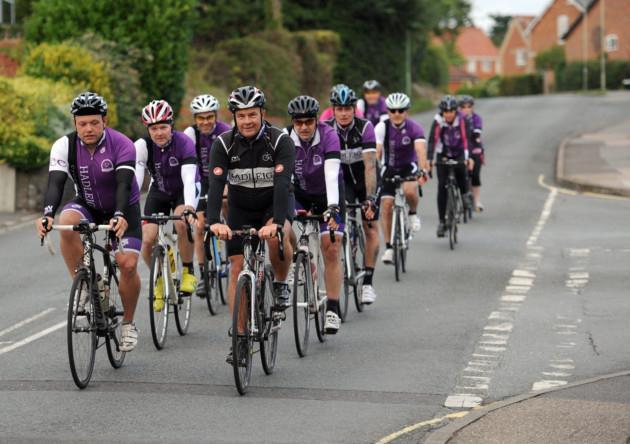- News
- Reviews
- Bikes
- Accessories
- Accessories - misc
- Computer mounts
- Bags
- Bar ends
- Bike bags & cases
- Bottle cages
- Bottles
- Cameras
- Car racks
- Child seats
- Computers
- Glasses
- GPS units
- Helmets
- Lights - front
- Lights - rear
- Lights - sets
- Locks
- Mirrors
- Mudguards
- Racks
- Pumps & CO2 inflators
- Puncture kits
- Reflectives
- Smart watches
- Stands and racks
- Trailers
- Clothing
- Components
- Bar tape & grips
- Bottom brackets
- Brake & gear cables
- Brake & STI levers
- Brake pads & spares
- Brakes
- Cassettes & freewheels
- Chains
- Chainsets & chainrings
- Derailleurs - front
- Derailleurs - rear
- Forks
- Gear levers & shifters
- Groupsets
- Handlebars & extensions
- Headsets
- Hubs
- Inner tubes
- Pedals
- Quick releases & skewers
- Saddles
- Seatposts
- Stems
- Wheels
- Tyres
- Health, fitness and nutrition
- Tools and workshop
- Miscellaneous
- Cross country mountain bikes
- Tubeless valves
- Buyers Guides
- Features
- Forum
- Recommends
- Podcast
feature
 2023 Jamie climbing Lanza road.cc kit out the saddle
2023 Jamie climbing Lanza road.cc kit out the saddleHow to improve your power-to-weight ratio — lose weight sustainably and get faster cycling up hills
As controversial as weight is around the cycling circles, it is true that power-to-weight ratio is an indicator of how fast a cyclist can go up the hills. The higher the number, the faster you are likely to climb up hills... but there is no need to overdo it.
We've talked to expert cycling coach Dave Scott and found out what power-to-weight ratio is, and added some nutrition and training tips on how you might improve your climbing competitiveness.
What is power-to-weight ratio?
While power-to-weight ratio isn't the absolute be-all and end-all to becoming a faster cyclist overall (bike handling skills certainly help going downhill), a lot of cycling is climbing up some sort of a hill, whether it's a false flat or an actual mountain climb.
"Ultimately a lot of the riding you're doing is going uphill. As soon as you start going uphill, as well as having to fight air resistance you are having to fight gravity. Essentially, the heavier you are, the more power you have to create to overcome that. This is why GrandTour winners are generally lighter riders because it's just much more efficient," Scott explains.
In short, power-to-weight ratio means the relationship between your power output (measured in watts) and your body weight (in kilograms). You might have seen the W/kg number circling around the indoor training apps, and it is the power-to-weight ratio that they use to explain the difficulty of the group ride or race. If you compare your power to others, W/kg is a better measure of your power than your functional threshold power (FTP), as it takes into account your weight.
"When two riders who are different weights are putting out the same power and start going up a hill, the lighter rider would be significantly faster. So even if they have the same relative power (FTP), they're going to be working at different intensities on a climb," Scott says.
So for example, if you have a rider who weighs 80kg and has relative power of 300 watts, their power-to-weight ratio is 300/80, which equates to 3.75 watts per kilogram of body weight. In comparison, a 50kg rider putting out 300 watts has a power-to-weight ratio of 6W/kg.
Something like 6W/kg is a very high power-to-weight -ratio, so don't worry if yours is nowhere near that! The average human who does a bit of leisure cycling averages 2W/kg, while for amateur cyclists 3W/kg is a good target. Professional riders are able to average 5.5 watts per kilogram for an hour, with those capable of winning a Grand Tour averaging a whopping 6.4 watts per kilogram for an hour.
> How to maximise your fitness when you get to 40+
As Scott pointed out, the power-to-weight ratio is most significant on hills. You might have noticed this on Zwift races if you have punched high and entered a category with a higher W/kg range than yours. You could keep up well on the flat, drafting, but once the group hits a significant climb over 6% and the speed decreases, your weight (or gravity) will be a much bigger contributing factor than the drafting.
From the start, it's important to distinguish the huge difference between WorldTour riders and Sunday club riders when it comes to climbing power: "WorldTour riders riding up a 6% climb might still be doing 30kph, so power-to-weight is not so important - you can still sit behind and be saving a lot of energy from the aerodynamics. But if you're doing 12-15kph up a 6% climb the factor slowing you down is almost exclusively the power-to-weight ratio," Scott illustrates.
Even if you don’t regularly tackle alpine climbs, it’s clear that there are performance benefits to having a high power-to-weight ratio even on the smaller climbs; but it's not the only measure of a fast or skilled cyclist.
"It's not so much of a factor on the flat, which is why cycling is quite a good sport. You can ride together on the flat even with mixed abilities," Scott emphasises.
As we've already mentioned, power-to-weight isn't the only thing that affects your speed, and there are other factors at play that are not even related to how fit you are. Mechanical friction, such as the rolling resistance of your tyres on the road and the bearings in the hubs and pedals can play a part, then there’s wind resistance. There's also aerodynamics, which is why time triallists spend so much time obsessing over their bikes and riding position. But those things are a whole other can of worms...
How do you start improving your W/kg?
Before you start changing your training or diet to get a better power-to-weight ratio, you need to figure out what your power-to-weight ratio is at the moment. The most common test to figure out your W/kg is called the Functional Threshold Power (FTP) test. This can easily be done on an indoor trainer, and most training apps offer you a ready-made ride option for testing, so all you need to do is get ready to suffer for an hour (or 20 minutes if you do the shortened test). If you have a power meter on your bike, you can also do the test outdoors.
Once you’ve figured out the current state of your climbing fitness, you can set a target for improving it; or if you’re content with the number you’re at, keep doing what you’re doing!
Do I have to lose weight to climb faster?
The short answer is yes.
"When it comes to improving your W/kg and you're a dedicated cyclist and have been for years, the gains you are going to get from improving your power is going to diminish, and what you can achieve is going to decline," Scott says.
"So generally the easiest way to improve your watts per kilo for the average cyclist is to lose weight. Most people have a couple of kilos they can shift.
"That said, it is very easy to say 'I'm gonna lose a couple of kilos' when in reality it can be quite difficult."
The gains you're going to get from losing weight depend on your base level. If you're already very lean and training hard, the gains are smaller. Talking about numbers, Scott gave some examples of what kind of time savings you can expect.
On national hill climb competitions, over a five to six-minute climb, if you lost a kilo of weight you also cut two or three seconds off your time.
"The general rule of thumb I go by is that for every hundred metres of elevation gain, for each kilo you lose, you save three seconds," Scott says.
Whether seconds matter to you is really up to you and what your aims and goals are. But to achieve those savings and shave off some weight, let's look at some nutrition tips on how to achieve them.
Make sustainable changes in your nutrition
Maintaining and increasing your muscle mass and losing fat is the key to improving your power-to-weight ratio, and that means putting your body in a state of negative energy balance – expending more energy than you consume.
Scott says that whatever you do in terms of your diet, it needs to be manageable and nothing drastic, so forget about keto or no-carb diets. He says in the long-term, those end with the weight coming back and generally more than what you've originally lost.
Scott says that figuring this out is a little more complicated and varies based on the individual a lot.
"The first thing I do with my clients is to look at what their current eating pattern is. So make a five-day food diary to look at what their daily calorie intake is. From rider to rider there is quite a difference in what their basic metabolic rate is," Scott says.
The basic metabolic rate is "the number of calories you burn as your body performs basic life-sustaining function". For an average woman, this might be only 1,800kcal a day, whereas, for a larger man, it might be closer to 3,000kcal a day - which means that cutting the same amount of calories would not work in the same way for these two individuals.
"You need to work out roughly what a day looks like, so what is going in and what is going out in terms of energy expenditure and whether the weight is staying the same. You then have a good idea of where your starting point is. From there you can calculate your calorie deficit - without going too drastic. You're only talking 10-15 per cent lower each day," Scott defines.
By adopting a moderate calorie deficit you may take a little longer to achieve large weight-loss numbers, but by doing it this way your body is not being shocked into starvation, and the weight loss can be controlled easily. Because it’s easy to maintain, it also results in longer-lasting results.
Scott estimates that you could look at losing half a kilo every week or fortnight, but this is really measured over a longer period of time as you can weigh yourself on one day and have lost the weight, but gained it back the next.
There are scenarios where cyclists lose a lot of weight in a short period of time for a specific event, with hill climb competitions being one example.
"It's important to categorise that correctly as well, they're not necessarily doing that as a healthy lifestyle change, they're doing it to win one race. So when you see people losing lots of weight in a short period of time that's very different to just overall losing weight for health and fitness," Scott emphasises.
Nutrition tips: from cutting out snacks to carbohydrates
Finding out how to lose weight can be confusing as there is a lot of information around and you can easily find conflicting claims about what works and what doesn't. Scott says that keeping things simple and not embarking on any kind of extreme cuts or additions is the best way: "I find the best way to start off with losing weight is to identify one or two things in your daily diet you can do without. It might be something as simple as that beer in the evening or a snack during the day.
"Another thing is to shorten your eating window. This means, for example, cutting off eating at 8pm and not eating until 9am in the morning. The biggest thing people get wrong is that they snack later on in the evenings, especially if they up their training," he says.
Carbohydrates are often a hot topic when it comes to weight loss, and even more so when associated with a sport such as cycling. Some say they perform well on a keto-diet, but Scott is more sceptical of drastically cutting carbs if you're trying to fuel for endurance sports:
"Although cycling is an endurance sport, a lot of it is done at relatively high intensity.
"Most of the time you're burning predominantly energy from your carb stores. If you don't take in enough carbohydrates from your diet there is a lot of evidence that suggests that you are not going to produce as good power numbers as you would if you were eating carbs.
"So yes, there might be some benefits in terms of fat metabolism [in cutting carbs] but you're reducing your training effect. It's similar to the debate about altitude training; train high and you can get adaption in terms of oxygen intake, but you can't train at anywhere near the intensity because of it. So you have a much-reduced training effect, which is why people now 'live high and train low'.
"I see some crossover here. By cutting out carbs you're just going to end up impacting your training."
> Cycling fitness: How to get the most from your indoor training sessions
Try some fasted training
Scott says there is nothing wrong with doing some fasted training, but clarifies that those should be low-intensity and only done once or twice a week.
"A lot of the evidence shows that there can be a small adaptation that is achieved in terms of your ability to metabolise fat at slightly higher intensities from doing fasted rides. At the same time, it is also mixed reviews, whether the gains from this are substantial and long-term," Scott adds.
> The myth of the fat-burning zone debunked
If you like the idea of fasted rides then it's worth trying it, as part of your commuting routine perhaps. Scott also says that doing fasted, long-intensity rides keeps you out of the house for longer, which keeps you away from snacks and could level out your hunger levels.
How long you can sustain fasted training will depend entirely on your training status and general cycling fitness. Pro riders can sustain three hours on a single espresso, but for those relatively new to the concept, ease yourself into it and don't try rides of longer than an hour to start with. The best time to do fasted training is before breakfast, as your body is likely to be in a depleted state after sleep.
> How to get the most from your limited training time
Scott emphasises that after your session or commute you need to consume a recovery meal or shake straight away as this helps your body adapt and recover from the training. Eating something that contains both carbohydrates and protein is ideal, for example, porridge, a low-fat cream cheese bagel or a recovery shake.
Whichever type of riding you do, remember to drink enough. Just because you're not eating during training, doesn’t mean you should neglect your hydration.
It's all individual to you. Don’t compare yourself to others!
Aiming for an ever higher W/kg number just because you are trying to match someone else's target is something we all easily get drawn into. It's worth trying to remember that we're all individuals, though, and not all of us have to be hammering up the hills like mountain goats.
Set realistic goals in improving your performance, and consider getting an expert coach to help you achieve them. There is so much conflicting nutrition and training advice out there, that you can likely find articles that contradicts everything said in this article. Some of it might work for you, some won't.
That's why reaching out to a professional coach is ideal. They are able to tailor training and nutrition plans to your needs and characteristics much better than your riding pals that all have different backgrounds... and it's very likely their backgrounds will not be in the field of cycling nutrition and performance, as much as they might be trying to help.
Weight loss is a very specific goal for an individual and depends on whether you are racing, commuting or just cycling for fun. Your power-to-weight ratio might be at the lower end of the scale, but you might be an excellent, fearless descender so you can catch everyone on the downhills. Or you might utilise your sprinting legs on the flats leading up to the claims. We all have our strengths, and the power-to-weight ratio is not the only measurement of those.
Work with what you have, and remember to keep cycling enjoyable!
Let us know your best tips for cycling fitness training below
Latest Comments
- SimoninSpalding 8 min 47 sec ago
I have a Ragley Trig, which is steel, has masses of clearance plus everything needed for racks, mudguards. I have it set up with a 2x10 Campag...
- thrawed 14 min 2 sec ago
Damn they messed up with this one, services like that grow from word of mouth. Who is going to be recommending komoot now when you need a...
- Robert Hardy 24 min 5 sec ago
If we consider the overtake of a large unaccompanied slow moving vehicle, agricultural machine or construction equipment that occupies the road to...
- bobbinogs 37 min 44 sec ago
Sir Bradders, retired from professional cycling to become a professional victim.
- Mr Blackbird 44 min 45 sec ago
Can't comment on whether it was Pogacar's greatest victory because I do not subscribe to TNT. Shame lots of other people didn't see the race either...
- wtjs 1 hour 15 min ago
Excellent, just the job! Thanks
- Rendel Harris 2 hours 37 min ago
Good point, it's England and Wales. Northern Ireland seem to have the same minimum and maximum penalties but I don't know if they work with the...
- David9694 2 hours 52 min ago
Our car-dominated urban environment is repressive and hot - let's see if we can desecrate the countryside ...
- chrisonabike 3 hours 20 min ago
Are you confusing a clearly opinionated - nay, biased rag like road.cc with a balanced, respectable news organisation like the BBC?
- Bigtwin 4 hours 37 min ago
"Welcome to your local Council - you don't have to be a moron to work here, but it really helps if you want to blend in".







Add new comment
5 comments
One other point to mention - higher w/kg also means you can ride at a lower %FTP for a given speed up a climb. So if you are interested in longer rides in mountainous country - especially multi day rides where recovery is a limiting factor, then being happy to ride at a lower percentage of FTP will damage your muscles less and allow you to go further and longer. You could just accept going more slowly, but sometimes you hit a gearing limit.
I am currently just over 90kg, and have about the same FTP as when I was a slender 85 kg, I ride some climbs near me which average 8% (I am lucky to live in a cycling paradise) and I use an 11-34 cassette with a 50/34 on the front. And at 90 kg, I struggle to keep out of the red in the lowest gear and keep a decent cadence on some ramps. Losing weight means I can do the climb in a comfortable cadence, or go slower and do more riding. Its not all about saving time, it could be gaining effective endurance.
This is something I've been caught by in recent years. Being a heavier guy, it takes more horses to drag my carcass over the hills. Luckily for me, I tend to have more horses under the hood than my lighter club mates, so I can generally keep up.
Problem is, by using those extra horses, I'm knackering myself; whilst my club mates are enjoying a relaxing long day in the hills, I'm spending more time at Z5 and above than I would during a dedicated VO2Max training session.
It took me far too long to get this, leaving me chronically overtrained, with (ironically) poor aerobic conditioning.
Ride at YOUR level kids!
"When two riders who are doing the same power on the flat, but are different weights and start going up a hill - one of them is 50kg and one of them is 80kg - and both of them are doing 5W/kg, the 50kg rider would be significantly faster. So even if they have the same relative power (FTP), they're going to be working at different intensities on a climb," Scott says.
This paragraph is a mess. Are the two riders both doing 5 W/kg on the flat (in which case the 50 kg rider is putting out 250 W, and the 80 kg rider 400 W) in which case the 80 kg rider is going far faster than the 50 kg rider?
Apologies, think that para must have got rather muddled in the editing phase. It's been changed.
You've lost me:
"When two riders who are doing the same power on the flat, but are different weights and start going up a hill - one of them is 50kg and one of them is 80kg - and both of them are doing 5W/kg, the 50kg rider would be significantly faster."
If they are both doing 5W/kg, I'd expect them to be going uphill at the same speed (= have the same VAM).
VAM is often used as a way to calculate W/kg.